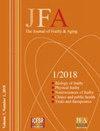Frailty Status and Outcomes of COVID-19 Patients Admitted to an Intensive Care Unit
IF 3.3
Q2 GERIATRICS & GERONTOLOGY
引用次数: 0
Abstract
Frailty assessment using the Clinical Frailty Scale (CFS) has been incorporated into COVID-19 decision aids as frailty highlights risk of poor outcome which can guide future care (1, 2). The critical care patient population continues to trend towards a younger, fitter and less co-morbid population (3). Yet, COVID-19 is a disease that disproportionately effects the elderly; people aged over 65 years represent more than 50% of Intensive Care Unit (ICU) admissions and account for 80% of mortality (1). There are subsequent ethical considerations as to how resources were and continue to be allocated. For this reason, it is relevant we understand how frailty has impacted clinical decisions which may then drive improvements in future practice. Frailty has sustained relevance in a critical care environment with continual scarcity of resources (3). We undertook a service evaluation of the mortality and hospital outcomes of COVID-19 positive patients admitted to Ysbyty Gwynedd (YG) ICU from 01/03/2020 to 01/06/2022. We considered the effect of ICU patients’ pre-admission frailty on their subsequent outcomes as well as comparing how CFS scores of admitted patients changed over the evaluation period. Patients testing positive for COVID-19 that were admitted to ICU were the sole population of interest. Patients aged 18 or over were considered eligible for the evaluation and patients with suspected COVID-19 that tested negative were excluded. Retrospective data was sourced from the Intensive Care National Audit & Research Centre (ICNARC) database, handover notes and clinical files. CFS scores were used to dichotomise the cohort into two distinct groups; one group with CFS scores 1-4 was defined as fit or vulnerable and the second group scoring between 5-9 was defined as frail. Patients were then assigned a pandemic ‘wave’ based on their date of admission: admission between 01/03/2020 to 01/09/2020 were assigned ‘Wave 1’ and between 01/09/2020 to 01/06/2021 ‘Wave 2’. 72 COVID-19 patients were included in the service evaluation; 65% of patients were male and the mean age was 59 years (SD 13). The population had a mean ICNARC score © Serdi and Springer Nature Switzerland AG 2022重症监护病房收治的COVID-19患者的虚弱状况和结局
使用临床虚弱量表(CFS)进行的虚弱评估已被纳入COVID-19决策辅助工具,因为虚弱突出了不良结果的风险,可以指导未来的护理(1,2)。重症监护患者群体继续趋向于更年轻、更健康和更少共病的人群(3)。然而,COVID-19是一种不成比例地影响老年人的疾病;65岁以上的人占重症监护病房(ICU)入院人数的50%以上,占死亡率的80%(1)。关于如何分配资源以及如何继续分配资源,存在随后的伦理考虑。出于这个原因,我们了解虚弱是如何影响临床决策的,这可能会在未来的实践中推动改进。在资源持续稀缺的重症监护环境中,虚弱一直具有相关性(3)。我们对2020年3月1日至2022年6月1日入住Ysbyty Gwynedd (YG) ICU的COVID-19阳性患者的死亡率和住院结果进行了服务评估。我们考虑了ICU患者入院前虚弱对其后续结局的影响,并比较了入院患者的CFS评分在评估期间的变化。入住ICU的COVID-19检测呈阳性的患者是唯一感兴趣的人群。18岁及以上的患者被认为符合评估条件,疑似COVID-19检测阴性的患者被排除在外。回顾性数据来源于重症监护国家审计与研究中心(ICNARC)数据库、交接记录和临床档案。使用CFS评分将队列分为两组;CFS评分1-4分的一组被定义为健康或脆弱,评分在5-9分之间的第二组被定义为虚弱。然后根据入院日期将患者分配为大流行“波”:2020年3月1日至2020年9月1日的入院被分配为“波1”,2020年9月1日至2021年6月1日的入院被分配为“波2”。将72例COVID-19患者纳入服务评价;65%的患者为男性,平均年龄59岁(SD 13)。人口的ICNARC平均得分©Serdi and施普林格Nature Switzerland AG 2022
本文章由计算机程序翻译,如有差异,请以英文原文为准。
求助全文
约1分钟内获得全文
求助全文
来源期刊

Journal of Frailty & Aging
GERIATRICS & GERONTOLOGY-
CiteScore
5.90
自引率
7.70%
发文量
54
期刊介绍:
The Journal of Frailty & Aging is a peer-reviewed international journal aimed at presenting articles that are related to research in the area of aging and age-related (sub)clinical conditions. In particular, the journal publishes high-quality papers describing and discussing social, biological, and clinical features underlying the onset and development of frailty in older persons. The Journal of Frailty & Aging is composed by five different sections: - Biology of frailty and aging In this section, the journal presents reports from preclinical studies and experiences focused at identifying, describing, and understanding the subclinical pathophysiological mechanisms at the basis of frailty and aging. - Physical frailty and age-related body composition modifications Studies exploring the physical and functional components of frailty are contained in this section. Moreover, since body composition plays a major role in determining physical frailty and, at the same time, represents the most evident feature of the aging process, special attention is given to studies focused on sarcopenia and obesity at older age. - Neurosciences of frailty and aging The section presents results from studies exploring the cognitive and neurological aspects of frailty and age-related conditions. In particular, papers on neurodegenerative conditions of advanced age are welcomed. - Frailty and aging in clinical practice and public health This journal’s section is devoted at presenting studies on clinical issues of frailty and age-related conditions. This multidisciplinary section particularly welcomes reports from clinicians coming from different backgrounds and specialties dealing with the heterogeneous clinical manifestations of advanced age. Moreover, this part of the journal also contains reports on frailty- and age-related social and public health issues. - Clinical trials and therapeutics This final section contains all the manuscripts presenting data on (pharmacological and non-pharmacological) interventions aimed at preventing, delaying, or treating frailty and age-related conditions.The Journal of Frailty & Aging is a quarterly publication of original papers, review articles, case reports, controversies, letters to the Editor, and book reviews. Manuscripts will be evaluated by the editorial staff and, if suitable, by expert reviewers assigned by the editors. The journal particularly welcomes papers by researchers from different backgrounds and specialities who may want to share their views and experiences on the common themes of frailty and aging.The abstracting and indexing of the Journal of Frailty & Aging is covered by MEDLINE (approval by the National Library of Medicine in February 2016).
 求助内容:
求助内容: 应助结果提醒方式:
应助结果提醒方式:


